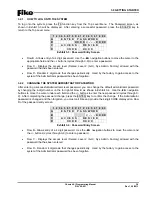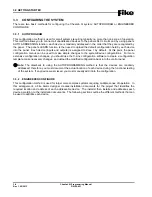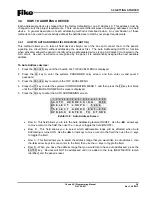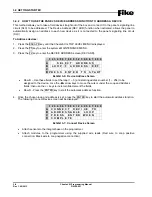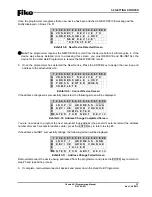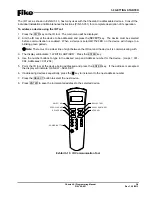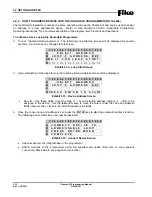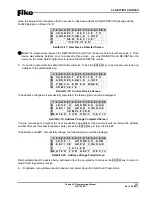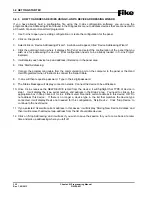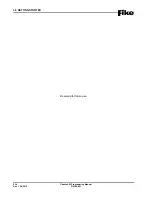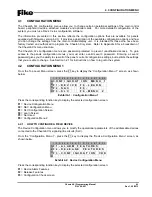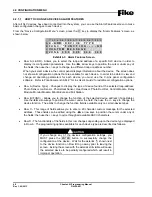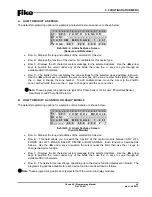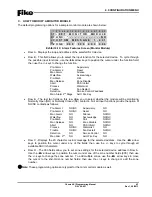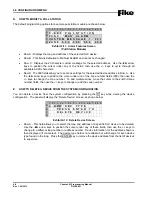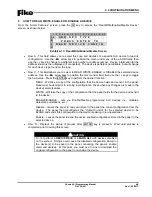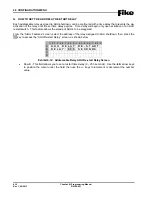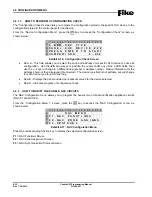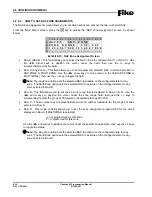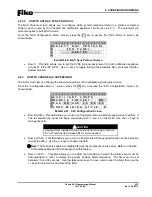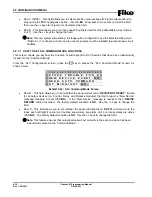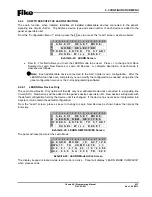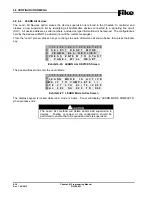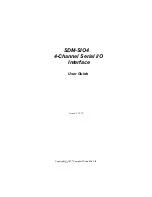
4.0 CONFIGURATION MENU
Cheetah Xi Programming Manual
4-3
P/N: 06-651
Rev 1, 09/2013
A. HOW TO MODIFY A SENSOR
The default programming options for a sample photoelectric smoke sensor are shown below:
1 2 3 4 5 6 7 8 9 0 1 2 3 4 5 6 7 8 9 0
A
1 - 0 0 1 : P H O T O
S E N S O R
B
F U N C : * - - - - - - - - - - - - - -
C
C U S T O M
M E S S A G E
1 - 0 0 1
D
Z O N E : 0 0 1
0 0 0
0 0 0
0 0 0
Exhibit 4-4: Alarm Features Screen
(Sensors and Detectors)
•
Row A - Displays the loop and address of the selected SLC device.
•
Row B - Displays the function of the device. Not editable for this device type.
•
Row C - Displays the 20 character custom message for the selected address. Use the
◄►
arrow
keys to position the cursor under any of the fields; then use the +/- keys to cycle through all
available ASCII characters.
•
Row D - The fields in this row display the zone settings for the selected device address in Row A.
Use the
◄►
arrow keys to position the cursor under one of the zone number fields (000); then use
the +/- keys to change the zone number. To add multiple zones, move the cursor to the 2nd-4th
zone number fields; then use the +/- keys to change or add the zone number.
L
Note:
These programming options are typical for Photo Sensor, Ion Sensor, Photo/Heat Sensor,
Heat Sensor and Photo Duct Detector.
B. HOW TO MODIFY A CONTROL OR RELAY MODULE
The default programming options for a sample control module are shown below:
1 2 3 4 5 6 7 8 9 0 1 2 3 4 5 6 7 8 9 0
A
1 - 0 0 1 : C O N T R O L
M O D U L E
B
F U N C : * - - - - - - - - - - - - - -
C
C U S T O M
M E S S A G E
1 - 0 0 1
D
- - - - : 0 0 0
0 0 0
0 0 0
P : *
Exhibit 4-5: Alarm Features Screen
(Control Module)
•
Row A - Displays the loop and address of the selected SLC device.
•
Row B - This field allows you to switch the function of the control module between ANY OF 3
ZONES, ALL OF 3 ZONES, SELECT DEVICE or ROW ANDING. Each function is described as
follows. Use the
◄►
arrow keys to position the cursor under the field; then use the +/- keys to
change the device function.
•
Row C - Displays the 20 character custom message for the selected address. Use the
◄►
arrow
keys to position the cursor under any of the fields; then use the +/- keys to cycle through all
available ASCII characters.
•
Row D - The fields in this row change depending upon the device function displayed in Row B. The
programming options available for each device function are described as follows.
L
Note:
These programming options are typical for both the control and relay modules.
Summary of Contents for 10-068
Page 111: ......

